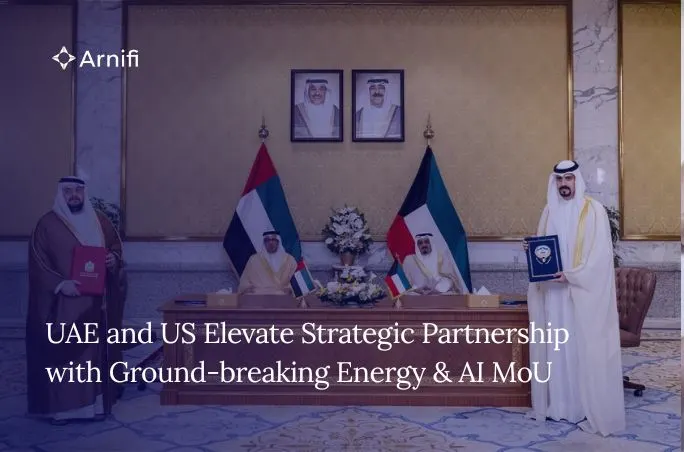UAE and US Elevate Strategic Partnership with Ground-breaking Energy & AI MoU
by
Ishika Bhandari
Nov 05, 2025  8 MIN READ
8 MIN READ

Table of contents
In terms of significant diplomatic and strategic moves, the date of 3 November 2025 saw Sheikh Mohamed bin Zayed Al Nayhan (MBZ), President of the UAE, receiving Doug Burgum, the United States Secretary of the Interior and Chairman of the National Energy Dominance Council (NEDC). Coinciding with ADIPEC 2025, this meeting laid the foundation for a historic collaboration between the two nations in the field of energy, AI, and industrial transformation.
During the visit, the two sides witnessed the signing of a Memorandum of Understanding (MoU) committing the UAE and the US to a broad set of cooperative initiatives aimed at accelerating advanced industrial capabilities, smart manufacturing, AI-driven energy systems, and supply-chain resilience.
Setting the Scene: A Strategic Moment
The timing of this meeting is far from incidental. The ADIPEC, inclined to be the flagship energy event in the world, is taking place in Abu Dhabi, offering it an appropriate platform for announcements to make headlines. The UAE and the US now send the signal that their partnership does not normally fall under energy diplomacy but rather embarks on a far-fetched future where power meets technology and economic security.
Not quite the same, for the US, Secretary Burgum serves simultaneously as Interior Secretary and Kimomozer of NEDC. This role establishes a convergence between energy policy, national security, and technology considerations in this context. At one point, he progressed to say that the world is in an “arms race” to build the energy infrastructure needed to power AI.
On the same account, the UAE has for a long time been presenting itself not merely as a hydrocarbon producer but rather as a hub for industrial transformation, advanced technology, and AI. This MoU is solidifying such ambition.
What the MoU Covers: Cornerstones of the Collaboration
The MoU signed by Dr. Sultan Ahmad Al Jaber, Minister of Industry, Advanced Technology, and Group CEO of Abu Dhabi National Oil Company (ADNOC) for the UAE, and Doug Burgum, behind the US, delineates an extremely thorough agenda.
Among the key highlights are:
- Joint ventures to enhance advanced industrial capabilities, such as smart manufacturing technologies and AI-enabled automation
- Develop smarter, adaptable energy systems such as smart grids, predictive maintenance, and enhanced energy-storage systems, and improve energy efficiency
- AI application in robotics, materials engineering, automation, and supply-chain resilience
- Technical and research collaboration programs, knowledge-sharing, and skills development through tailored leadership and specialist training
- To align with the UAE’s broader ambition to make the country a global hub for industry and advanced technology under its National Strategy for Industry & Advanced Technology
While the partners are presenting this MoU as a bilateral template, they are envisioning it to be a “future-ready” framework for industrial transformation and resilience in the economy, the most important context being AI-driven energy demand.
Strategic Drivers: Why This Matters
1. The Energy–AI Nexus
According to Secretary Burgum’s comments, there is a clear connection between energy capacity and AI dominance. “This is the first time in history that you can take a kilowatt of electricity and actually convert it directly into intelligence,” he said, stressing that without enough energy infrastructure, a nation risks losing the “AI arms race.”
For both the USA and UAE, AI is not just about technology; it is about creating a prosperous manufacturing environment, self-sustaining supply-chain competitiveness, and national security, as well as economic growth. The MoU bears witness to this convergence.
2. UAE’s Diversification & Industrial Ambition
Diversification was made a national priority in the UAE, which has undergone a strategic shift recently. Beyond hydrocarbons, its focus now includes advanced manufacturing, AI, high-tech supply chains, and energy systems integration. This MoU bolsters “Make it in the Emirates” through underlining supply-chain resilience and high-tech manufacturing.
3. US Strategic Partnerships & Geoeconomic Competition
For the United States, deepening relations with the UAE means having access to capital, technology, and a steady regional partnership. In an energy-and-technology world completely bound up by geopolitics, the MoU temporarily strengthens Washington’s position in the Gulf and globally on the technology-energy competition.
4. Building Resilient Economies
Both countries have resilience, whether in energy, industrial supply chains, or economies. The MoU makes smart manufacturing, AI in energy, and training seem more inclined to a future in which pure resources are no longer the basis of economies, but knowledge and technology.
The Broader Landscape: Context and Precedent
The Amu finds itself in the context of intensifying US-UAE cooperation in energy, technology, and investment. Earlier in 2025, the UAE will commit to a 10-year, US$1.4 trillion investment framework in the United States, focusing on AI infrastructure, semiconductors, energy, and manufacturing. The UAE will also increase investment in energy in the US to around US$440 billion by 2035. This is indicative of the scale at which they cooperate.
Moreover, the council, chaired by Burgum, the NEDC, has put it on record that boosting electricity generation by ten to fifteen percent is needed for AI-driven growth in the US.
That, therefore, creates a wider strategic pattern. Flow of capital, technology partnerships, and joint endeavors at addressing the new energy-AI convergence shaping the decade to come.
What Lies Ahead: Key Questions and Challenges
Execution is everything, despite the MoU putting down a very bold plan. Some of the critical issues to monitor include:
1. Implementation and Timeline
- What will be the flagship projects established under this MoU?
- How soon will smart grids develop in both countries along with AI-enabled robotics, energy storage, and manufacturing facilities?
- How will milestones be assessed for progress transparency?
2. Technology and Supply Chains
- AI and manufacturing require high-end semiconductors, robotics manufacturing, and materials engineering. Is the UAE set to gain access through US companies? Will joint ventures be established, and how will intellectual property and know-how transfers be managed?
- Supply chain resilience, both energy and advanced manufacturing, would remain a priority. Localisation of production or dependency on global nodes for both energy and advanced manufacturing: which of the two would the UAE-US partnership undertake?
3. Energy System Transition and Environmental Factors
- Although the MoU talks about energy systems, how does this relate to decarbonisation? This is not a “low carbon” agreement in itself, but the prospect is that the intensive energy draw of AI growth clashes with climate commitments.
- Will there be any common frameworks around sustainability, emissions, or green hydrogen, or is it simply a matter of focusing on capacity and resilience?
4. Geopolitical Implications
- Ties between the US and the UAE are strengthened in their energy-AI capacity. This could see reactions from other regional actors, part of a much greater scheme of things concerning the UAE’s foreign-policy calculus.
- Such partnerships that strengthen energy-AI capacity for the US will also strengthen competition between it and China and others. How visible would it become on the international stage?
Significance for India and the Region
However, this MoU is a bilateral one between the UAE and the USA, but it will perhaps have its ramifications felt beyond the Middle East and possibly in Asia and other global markets in energy technology, India.
The energy transition in India and its quest for an AI-infused manufacturing ecosystem may also find ramifications in supply chains, capital flows, and technology availability.
The UAE’s emergence as a manufacturing hub for advanced technology may spur healthy competition but may also foster trilateral cooperation.
Countries like India will have to ensure that as the world’s energy systems increasingly embrace AI, they are not relegated to an inferior position in the newly forged industrial-technological supply chains.
Concluding Thoughts
The MoU signed in Abu Dhabi on 3 November 2025 shall henceforth be understood as a new watershed moment in US-UAE relations. Apart from conventional energy diplomacy, it moves beyond raising the relationship to that of industrial transformation, advanced manufacturing, and the AI-energy nexus.
In concrete terms, for the UAE, it is a step forward toward eventually becoming a hub for industry and advanced technology. For the United States, it is a strategic link that positions energy and technology as intrinsic to national security considerations. Implementation would determine how disruptive this deal becomes, but the ambition is clear.
As superior legislation increasingly inflates kilowatts with intelligence-based energy and powers the next wave of industrial growth, the future of the UAE-US partnership will indeed provide a framework by which countries may compete and collaborate in the emergent AI-powered global economy.
As one US official said, “If we don’t have the power, we’ll lose the AI arms race.”
For the time being, the UAE and the USA have their agenda set and an accord signed. This will be an interesting show for the world to watch as they deliver and receive the responses from other nations.
Top UAE Packages

Related Articles
Top UAE Packages



